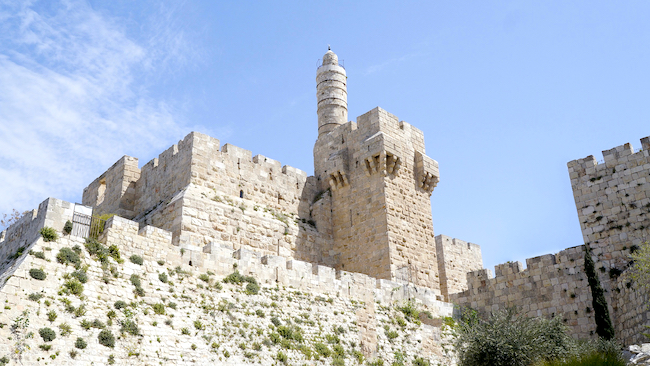
Yechezkel 44:15
This week’s haftorah discusses the laws of the kohanim during the Messianic era. The prophet Yechezkel devotes special attention to the regulations of the kohanim and to their priestly garb. He states the kohain’s restriction from drinking wine or shaving his head and makes mention of his prohibition of marrying a widow or divorcee. At first glance these details seem to be a total repetition of the laws in this week’s parsha. However a more careful examination reveals to us a shocking dimension of the era of Mashiach and the elevated status of the kohanim during those times. According to the comments of the Radak, Abravanel and Malbim throughout the haftorah it is apparent that the status of the ordinary kohain will undergo a radical change and will reflect an elevated lifestyle of sanctity and purity. In essence it appears that the status of the ordinary kohain in the time of Mashiach will parallel that of the Kohain Gadol in earlier times.
Some of the noticeable changes include the following regulations. Although the ordinary kohain is restricted from marrying a divorcee, he need not marry a virgin and is certainly permitted to a widow. Yet according to the understanding of Radak, the ordinary kohain in the Messianic era will be restricted (with one exception) to the marriage of a virgin. (see commentary to 44:22) The ordinary kohain was forbidden to serve in the Bais Hamikdash with overgrown hair however no specific regulations were given regarding his general hair length. But according to the Radak (44:20) the kohain of the future, like the present Kohain Gadol, will be required to maintain an extremely short hairstyle. The ordinary garb of the kohain consisted of multi-colored wool and linen but the kohain of the future, like the Kohain Gadol on Yom Kippur, will wear strictly linen garb. (see Radak 44:16) This garb will even assume the supreme sanctity of the Yom Kippur garb and will be forbidden to be taken outside of the walls of the Bais Hamikdash.
These new regulations suggest that the elevated status of the ordinary kohain of the future will be tantamount to that of the present Kohain Gadol. In fact, some of these regulations were previously limited to the elevated Yom Kippur service of the Kohain Gadol. The conclusion we draw from here is that the ordinary Temple service of the Messianic era will be on par with that of the Kohain Gadol of earlier generations. And in certain ways the elevated experiences of the Kohain Gadol on Yom Kippur in the Holy of Holies will eventually become the daily experience of the ordinary kohain in the times of Mashiach.
In order to appreciate this overwhelming phenomena it is important to understand the mind set and sanctity of the Kohain Gadol. In this week’s parsha, the Torah gives us the reason for the elevated status of the Kohain Gadol. After listing many of his specific regulations the Torah adds, “And he should not leave the Mikdash so as not to profane the sanctity of Hashem because the crown of Hashem is upon the Kohain Gadol’s head.” (Vayikra 21:12) The Sefer HaChinuch (Mitzva 270) gives us insight into the intriguing concept of “the crown of Hashem”. Before quoting his words it is of value to study the opinion of the Rambam (Klei Hamikdash 5:7) who is of the following opinion. Rambam maintains that the Kohain Gadol was permanently confined to his designated chamber in the Bais Hamikdash throughout each day of service. In addition the Rambam notes that the nightly quarters of the Kohain Gadol were restricted to Yerushalayim proper and under no circumstances could the Kohain Gadol ever leave the Holy City. The Sefer Hachinuch explains that this constant and total focus on Hashem and His service yielded the supreme quality of the Kohain Gadol.
He therefore characterizes the Kohain Gadol in the following terms. “The Kohain Gadol was isolated from all in order to be elevated to the perfect status of sanctity. Although he was a physical being, his soul dwelled constantly amongst the heavenly servants. Due to his total preoccupation with spirituality he was elevated above the rest of humanity and removed from all mundane interest and worldly concerns. The Chinuch views the elevated status of the Kohain Gadol’s sanctity a result of his total immersion in the service of Hashem. His perfect spiritual surroundings, intense focus on sacrifice and constant awareness of the presence of Hashem produced the holiest man on earth. This is what the Torah means when referring to the crown of Hashem worn by the Kohain Gadol. His mind and total preoccupation were purity and sanctity and he literally carried Hashem in his mind at all times. It is this mind set which produced the strict regulations and limitations of the Kohain Gadol, reflecting an elevated life style of perfect sanctity. In essence, the Kohain Gadol’s life-style was restricted to one of perfect sanctity because his entire interest and focus was also one of purity and sanctity.
We now begin to understand and appreciate the status of the ordinary kohain during the Messianic era. In general we are told that the focus of the entire world will be one of purity and sanctity. The prophet Yeshaya speaks of the illustrious era of Mashiach and presents it in the following terms. “And the land will be filled with the knowledge of Hashem like the water fills the sea.” (Yeshaya 11:9) Rambam elaborates upon this and states, “And in this time there will be no jealousy or quarrel… and the preoccupation of all will be ‘to know Hashem’…and the Jewish people will be great scholars who will understand Hashem to the maximum human capacity.” (M’lochim 12:5)
It stands to reason that if this will be the elevated understanding of the ordinary Jew, how much greater will be the level of the kohain who is privileged to serve Hashem daily and stand in His presence?! We can safely say that the ordinary Kohain’s indescribable understanding of Hashem coupled with his direct and constant contact with Hashem will truly yield extreme levels of sanctity. His general status will be tantamount to that of the earlier Kohain Gadol and even share aspects of the “Holy of Holies.” We now understand the specific regulations of the ordinary kohain of the future. His total interest will be focused on spirituality and, like the Kohain Gadol of previous times, will be removed from mundane involvement and worldly concerns. It therefore follows logically that the ordinary kohain’s lifestyle will be akin to that of the Kohain Gadol, one of elevated purity and sanctity reflecting the “crown of Hashem” worn upon his head. May we soon merit to experience such elevated levels of sanctity, so sorely missing in our times.


